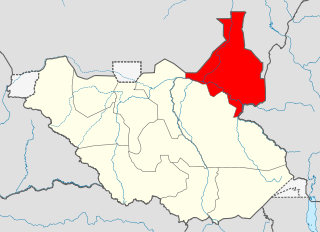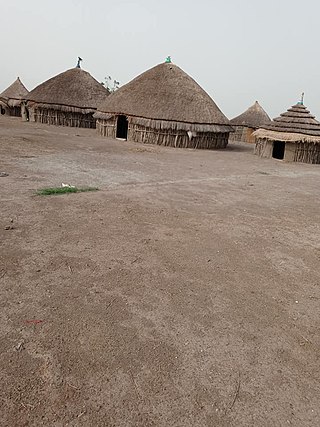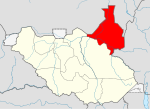
Upper Nile is a state in South Sudan. The White Nile flowes through the state, giving it its name. The state also shares a similar name with the region of Greater Upper Nile, of which it was part along with the states of Unity and Jonglei. It had an area of 77,823 square kilometres (30,048 sq mi). Malakal was the capital of the state. The towns of Upper Nile State Benythieng Akoka, Melut, Renk, Kodok, the location of the Fashoda Incident that ended the "Scramble for Africa", was located in the state. Upper Nile seceded from Sudan as part of the Republic of South Sudan on 9 July 2011.

Jonglei State is a state of South Sudan with Bor as its centre of government and the biggest city. Jonglei state comprises nine counties: Bor, Akobo, Ayod, Uror, Duk, Nyirol, Pigi, Twic East, and Fangak. Jonglei State is the largest state by area before reorganisation, with an area of approximately 122,581 km2, as well as the most populous according to the 2008 census conducted in present-day South Sudan's second period of autonomy. The boundaries of the state were again changed as a result of a peace agreement signed on 22 February 2020.

Bor is a historic city in the Bor County of Jonglei State, in the Greater Upper Nile region of South Sudan, being the epicenter of national liberation revolution with multiple landmarks that tells the story. In Malual-Chaat barrack, statues of liberators and destroyed weapons are conserved and exhibited at historical heritage site. It has also served as the headquarters of Jonglei state. The city is situated on the east side of the White Nile at the southern extent of the sudd, South Sudan's vast central wetlands.

Malakal is a city in South Sudan, serving as the capital of Upper Nile State in the Greater Upper Nile region of South Sudan, along the White Nile River. It also serves as the headquarter of Malakal County and it used to be the headquarter of Upper Nile Region from the 1970s to the late 1990s.
Renk is a town in South Sudan.

Southern Sudan was an autonomous region consisting of the ten southern states of Sudan between its formation in July 2005 and independence as the Republic of South Sudan in July 2011. The autonomous government was initially established in Rumbek and later moved to Juba. It was bordered by Ethiopia to the east; Kenya, Uganda, and the Democratic Republic of the Congo to the south; and the Central African Republic to the west. To the north lies the predominantly Arab and Muslim region directly under the control of the central government. The region's autonomous status was a condition of a peace agreement between the Sudan People's Liberation Army/Movement (SPLA/M) and the Government of Sudan represented by the National Congress Party ending the Second Sudanese Civil War. The conflict was Africa's longest running civil war.
Ikotos County is an administrative area in the Eastern Equatoria state of South Sudan with headquarters in the town of Ikotos. The people, who live in the county's area by subsistence agriculture and cattle herding, are poverty-stricken. Years of civil war have made violence commonplace: most people have experienced the murder of a close family member. In 2009, AK-47 rifles were used in 42 per cent of killings.
Melut County is an administrative area of Upper Nile State in the Greater Upper Nile region of South Sudan.
Ethnic violence in South Sudan has a long history among South Sudan's varied ethnic groups. South Sudan has 64 tribes with the largest being the Dinka, who constitute about 35% of the population and predominate in government. The second largest are the Nuers. Conflict is often aggravated among nomadic groups over the issue of cattle and grazing land and is part of the wider Sudanese nomadic conflicts.
Longechuk County is an administrative area in Upper Nile State, in the Greater Upper Nile region of South Sudan.
Baliet is an administrative county in the Upper Nile State, South Sudan. The County headquarters is the town of Baliet, located on the north side of the Sobat River 20 km south east of Malakal, the capital city of Upper Nile State.
Fashoda County is an administrative area in Upper Nile State, in the Greater Upper Nile region of South Sudan.
Uror County is an administrative area of Jonglei State in the Greater Upper Nile region of South Sudan. It has nine payams: Pathai, Pieri, Pulchuol, Palouny, Motdit, Motot, Karam, Pajut, Weykol and Padiek.
Malakal County is an administrative area in Upper Nile State, in the Greater Upper Nile region of South Sudan.
Maiwut County is an administrative area of Upper Nile State in the Greater Upper Nile region of South Sudan.
Panykang County is an administrative area in Upper Nile State, in the Greater Upper Nile region of South Sudan.
Renk County is an administrative area in Upper Nile State, in the Greater Upper Nile region of South Sudan.

Latjoor was a state in South Sudan that existed between 2 October 2015 and 22 February 2020. It was located in the Greater Upper Nile region and it bordered Eastern Nile to the north, Eastern Bieh to the south, and Ethiopia to the east.

In the early months of 2017, parts of South Sudan experienced a famine following several years of instability in the country's food supply caused by war and drought. The famine, largely focused in the northern part of the country, affected an estimated five million people. In May 2017, the famine was officially declared to have weakened to a state of severe food insecurity.

Bukteng is a small town located in the Ulang County of Upper Nile State, in the Greater Upper Nile region of South Sudan. It is situated approximately 10 kilometers south of Jikmir. BukTeng has a population of approximately 2,000 to 3,000 people, primarily from the Nuer ethnic group.









